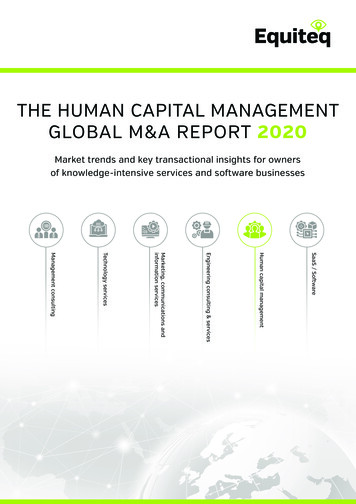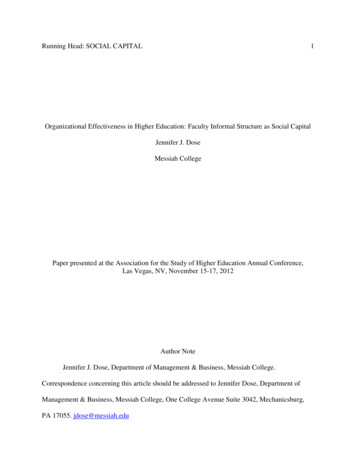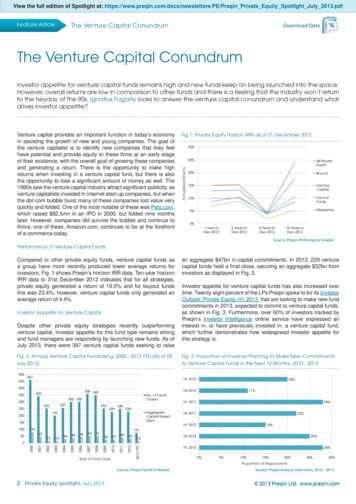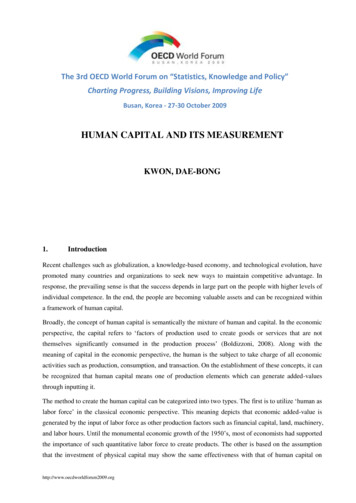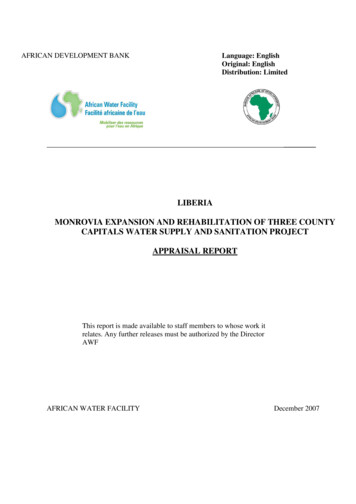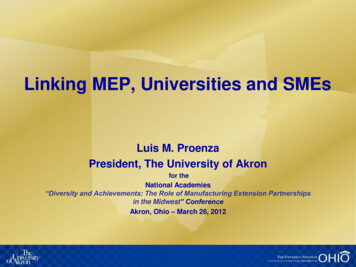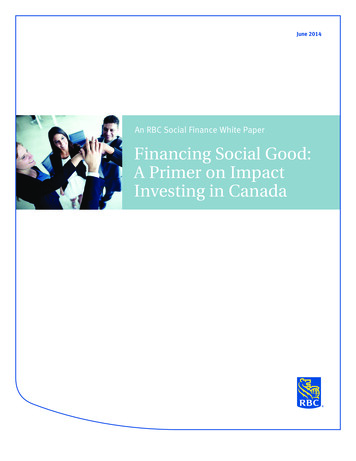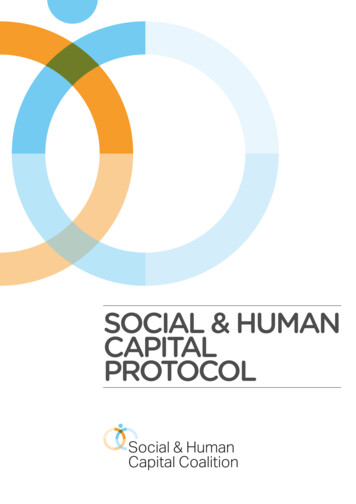
Transcription
SOCIAL & HUMANCAPITALPROTOCOL
SOCIAL & HUMAN CAPITAL PROTOCOLContentsORIENTATION 1STAGE 1: FRAME 8Step 01: Get started 9STAGE 2: SCOPE 18Step 02: Define the objective 19Step 03: Scope the assessment 25Step 04: Determine the impacts and/or dependencies 29 STAGE 3: MEASURE AND VALUE 41Step 05: M easure impact drivers and/or dependencies 42Step 06: Measure changes in the state of social and human capital 47Step 07: Value impacts and/or dependencies 52STAGE 4: APPLY 63Step 08: Interpret and test the results 64Step 09: Take action 67NEXT STEPS: 73List of tables, figures and boxes 73Acknowledgments 74References 76
OrientationThe need for actionDespite growing awareness, there is little consensus on how businesses can measure andassess the value of social and human capital resources. The development of measurementand valuation approaches – particularly in relation to social capital – is still in its infancy.Even when CEOs and other decision-makers recognize the value of assets such ascommunity relationships or employee talent, they are unable to translate this valueconsistently into terms that people inside and outside their businesses can understand,trust and, most importantly, use. As a result, businesses struggle to embed these factorsinto processes such as strategic decision-making and communications. In many cases, thisleads to undervaluing and consequently, underinvesting in the people and relationships onwhich businesses and society depend.As we look to the future, demonstrating business value to society will become increasinglyimportant, driven by four principal megatrends that are shaping the world and driving thepace of change: globalization, technology, demographic changes, and climate change. Forbusinesses, there is an urgent need to understand the negative and positive impacts ofthese megatrends on business models, strategy and operations. This is because thesemegatrends effectively change the nature of work, the relationship between the employerand the worker, skills and education, social dialogue dynamics and industrial relations.These issues are linked to the digital divide, the platform economy, the business climateand legal framework, social protection systems, the education and training systems anddata protection, among many others (IOE 2017).The Social & Human Capital Coalition believes the assessment and management ofcorporate performance needs to incorporate social and human capital alongside financialand environmental performance. The Coalition is therefore committed to delivering acredible, comparable and broadly accepted approach to social and human capital impactmeasurement and valuation - as outlined in this Protocol - that enables businesses to trulyvalue people and relationships as a driver of sustainable growth.1SCOPEMEASURE & VALUETo do well in today’s world, businesses must establish effective social dialogue at theenterprise level and/or between employer and business organizations, and workers’representatives, and implement robust systems that build an understanding of the positiveand negative value they create beyond financial returns and how such value is distributed.APPLYIn September 2015, all 193 United Nations (UN) member states ratified a set of 17Sustainable Development Goals to provide a framework for achieving global prosperitywithin the limits of the planet. Momentum from this revitalized global agenda alongsidegovernment policy, investor requests and consumer sentiment are all driving businesses tobetter manage and integrate social and human capital impacts and dependencies intotheir core business strategies.NEXT STEPSIn the current global context, ensuring this well-being presents multiple challenges.Persistent poverty, inequality, economic instability and a widening skill gap all impactbusiness value despite significant advances in economic development. No longer canbusinesses rely solely on financial assets or returns on financial capital to evaluate theirrisks and opportunities. They must also understand how trends and shifts in society willaffect them and how their actions influence society.FRAMEORIENTATIONPeople are at the core of business. They are your employees, customers, suppliers,distributors, retailers and neighbors. They determine whether you have a productiveworkforce, loyal customers, healthy value chains, vibrant local communities andsupportive governments. Their growth, prosperity and well-being matter and they arecrucial to the success of your business.
SOCIAL & HUMAN CAPITAL PROTOCOLOrientationOrientationIntroducing the Social & Human Capital ProtocolThe Social & Human Capital Coalition aims to make businesses that truly value peoplemore successful by mainstreaming the assessment of social and human capital – shiftingthe consideration of social and human capital performance from an optional extra to acore part of business decision-making. This Protocol is a key Coalition resource, settingout many of the foundational principles for measuring and valuing social and humancapital.The Protocol is the result of four years of collaborative development – involving input fromover 50 forward-thinking businesses, a public consultation exercise with more than 250parties and input from a range of expert partners.The Social & Human Capital Protocol is intended as a generally accepted framework forbusiness to measure and value social and human capital.As shown in Figure 1, the Protocol consists of four Stages, each with corresponding Stepsfor you to follow in order to understand, measure, value and improve your business’s socialand human capital performance.Stage 1FRAMEStage 4Stage 2APPLYSCOPEStage 3MEASUREAND VALUEFigure 1:Stages of the Social & Human Capital Protocol2
You can use the Protocol to measure and value the social and human capital impacts anddependencies of your whole business or an individual project, product or operation. TheProtocol seeks to determine: how (and by how much) your business activities increase,decrease and/or transform social and human capital, and the extent to which you dependon social and human capital resources. A long-term aspiration of the Coalition is that everybusiness using the Protocol will scale and integrate this approach across theirorganization.ORIENTATIONThe Protocol is a voluntary framework that provides a consistent process designed togenerate fit-for-purpose information for business decision-making. By following the Stepsin the Protocol, you can build a customized approach based on a range of availabletechniques for social and human capital measurement and valuation. See the conceptsand definitions section (in Step 1) for further details on how we are developing thisterminology and applying it to a business context.FRAMEA consistent process to guide businesses in measuring and valuingtheir social and human capitalAlthough the Protocol leaves open the choice of specific metrics and valuation andmeasurement approaches to users, it aims to provide you with guidance – and thereforeconfidence – in understanding the techniques that leading businesses currently apply andthat you could use within your organization. It also aims to develop a solid foundation forfuture progress on comparability and standardization.SCOPEThe Protocol does not assume or require that you report assessment results externally.Nevertheless, you may wish to report your assessment findings to demonstrate how youhave considered relevant social and human capital risks, opportunities and value creation.A framework for collaborative action on harmonized approachesMEASURE & VALUEEven though there is growing guidance available at the national and supranational leveland increasing convergence among standard setters, the business application of socialand human capital measurement and valuation is still at an early stage. The long-termaspiration of the Social & Human Capital Coalition is to move to harmonized andcomparable techniques for social and human capital measurement and valuation.To achieve this aspiration, the Coalition will provide a platform to consolidate andharmonize approaches, collate examples and guide businesses to the most current tools,data sources and good practices in relevant techniques. The ongoing application of theProtocol will help the Coalition identify gaps to fill and steer practitioners with commoninterests to collaborate in advancing current practices.APPLYOver the coming years, the Social & Human Capital Coalition will therefore shape anddrive collaborative action to achieve four goals: Mobilize: a network of business champions at both the chief executive and operationallevels to advocate for implementation and collaboration. Harmonize: technical approaches within the Social & Human Capital Protocol bypromoting awareness, acceptance and uptake by business, governments and key globalplatforms. Work in partnership with Coalition organizations and other initiatives to enablebusinesses to capitalize on their implementation of the Social & Human Capital Protocolby supporting the finance community and capital markets to continue to recognize andreward social and human value creation.Find out more at: www.social-human-capital.org3NEXT STEPS Socialize: the Social & Human Capital Protocol with the most important practitionersand expert organizations in this space, building a network and community to drive newthinking, global engagement and best practice.
SOCIAL & HUMAN CAPITAL PROTOCOLOrientationBox 1: Connected initiativesDriving integrated thinkingThe Protocol is part of a broader movement to enable businesses to integrate people,planet and profit as drivers of sustainable growth.Over the last few years, the integrated thinking and reporting movement has madesignificant strides in shifting views about business value creation. It has demonstratedthe importance of measuring and valuing interactions with society and provided aframework to consider the interlinkages between financial capital and social andenvironmental externalities. Corporate reporting is now undergoing a new drive forimproved harmonization of metrics and methods (spearheaded by the CorporateReporting Dialogue; CRD) that mirrors and compliments the work of the Social & HumanCapital Coalition.Against this backdrop, the Social & Human Capital Protocol seeks to contribute tointegrated reporting and sustainable value creation as outlined by organizations such asthe International Integrated Reporting Council (IIRC), Sustainability AccountingStandards Board (SASB), Accounting for Sustainability (A4S) and the Global ReportingInitiative (GRI), among many others.While these organizations focus largely on external reporting and disclosure, businessesstill struggle with understanding their impacts in a way that provides useful andactionable information for internal decision-makers to strengthen their social and humancapital for the benefit of society and business. The Social & Human Capital Protocol aimsto bridge this gap, as detailed in our joint statement with IIRC (Social & Human CapitalCoalition & IIRC 2018).Integrating approaches between social, human and natural capitalThe same purpose, concepts and principles drive the Social & Human Capital Protocol as drivethe Natural Capital Protocol - released by the Natural Capital Coalition in 2016. Both Protocolsare critical parts of an evolving set of business resources to ensure social and environmentalrisks and opportunities are considered in corporate strategy and decision-making.The Social & Human Capital Protocol mirrors the structure and guidance in the NaturalCapital Protocol – indeed, much of the content contained in this document owes agreat deal to the pioneering work of the Natural Capital Coalition, from which it hasbeen sourced. Such material has been adapted to the more diverse frames of referenceand maturity levels in the social and human capital measurement and valuation field. Inaddition, the Social & Human Capital Protocol incorporates terminology and frameworksused by practitioners and experts across human and worker rights, social impactassessments, social return on investment, monitoring and evaluation, social life-cycleanalysis and product social metrics, among other areas of relevance.Nevertheless, to achieve a truly holistic picture of an organization’s impacts anddependencies, business should not consider social and human capital in isolation butrather as part of a holistic assessment of non-financial capital. After all, it is impossible tovalue natural capital without applying an anthropological lens; inversely, some of thedefining issues of our age impact people and society through changes in natural capital– climate change for example.It is the Social & Human Coalition’s ambition, therefore, to further stimulate thedevelopment and harmonization of social and human capital measurement andvaluation, until we reach a point where we can further integrate this work with naturalcapital – an ambition we share with our colleagues in the Natural Capital Coalition(Social & Human Capital Coalition & Natural Capital Coalition 2018).Users of this documentThe Coalition envisages that there will be a range of users and associated benefits fromadopting this Protocol. You may be involved in considering your business’s wider impactsand how best to measure and manage these. You may be in government and want tounderstand how to assess how businesses interact with their employees, communities andother stakeholders. You may be an employer organization and want to guide yourmembers who may be interested to evolve business models, strategies and operations tocounter the disruptive (and maximize the positive) impacts of the future of work. Whateveryour role, it will be vital to work with colleagues from multiple functions in order to fullyunderstand and address issues raised in the Protocol (see further guidance in Box 4).4
Technical principlesWe have designed the Protocol as a flexible approach that businesses and stakeholders indiverse settings can tailor to their needs. You will make your own choices about how todetermine the scope, metrics, methods and techniques that are most appropriate for yourcontext. The four principles below aim to guide you when making these choices, especiallywhen addressing specific social issues that the Protocol does not elaborate on.ORIENTATIONTechnical and ethical principles Relevance: Ensure the consideration of the most relevant issues throughout your socialand human capital assessment, including the impacts and/or dependencies that aremost material for your business and stakeholders. This will help you identify the mostimportant relationships between your business’s activities and social and human capitalimpacts and/or dependencies. Note: relevance is a principle to adhere to throughout theapplication of the Protocol, as opposed to materiality, which Step 4 considers further.FRAMEThese principles align with the Natural Capital Protocol, which itself builds on guidancefrom the GRI, the World Resources Institute/WBCSD Greenhouse Gas Protocol and theClimate Disclosure Standards Board (CDSB): Replicability: Ensure that all your assumptions, data, caveats and methods aretransparent, traceable, fully documented and repeatable. This facilitates the iterativedevelopment and application of your approach and implementation across yourbusiness, and may allow for verification or audit if required. Consistency: Ensure the data and methods you use for each assessment are compatiblewith each other and with the scope of the analysis. This will support you as you scaleand integrate measurement and valuation across your business.Ethical principles: The Social & Human Capital CharterThe measurement and valuation of social and human capital is a relatively new concept.Potential exists for misunderstandings, particularly with regard to “hard-to-value issues”,such as health and life, “trade-offs” between different social and human capital issues orstakeholders affected, the intent of external communication and possible lack oftransparency in measures and values.MEASURE & VALUESCOPE Rigor: Use fit-for-purpose, technically robust information, data and methods. This willensure the data your analysis produces is as reliable as possible for the context in whichit was produced.APPLYWith these issues in mind, the Coalition has also developed a Social & Human CapitalCharter to guide businesses in conducting social and human capital measurement andvaluation and making judgments about how to interpret findings.You can find the Social & Human Capital Charter at: protocol/social-human-capital-charterThe purpose of this Charter is to highlight key ethical issues that Protocol users shouldconsider and to help ensure that its application leads to the protection, maintenance and,where possible, enhancement of people’s rights, skills, experience, knowledge and health,in addition to societies’ shared values, norms and institutions.NEXT STEPSYou can use the Social & Human Capital Protocol to measure your business’s impactsrelating to avoiding, preventing and actively addressing illegal activities such as childlabor, forced labor and breaches of health and safety requirements. Some businesses arealready reporting on these topics as signatories to certain international agreements. TheProtocol seeks not to replace but to support such agreements by helping businesses toclarify the business and societal value of a robust response to these issues.5
SOCIAL & HUMAN CAPITAL PROTOCOLOrientationStructure of the Social & Human Capital ProtocolThe Social & Human Capital Protocol consists of four Stages, each of which includes aseries of supporting Steps. As shown in Figure 2, the Stages and Steps are iterative: youshould expect to revisit previous Steps as necessary.The Protocol describes the actions you need to complete under each Stage and providesguidance and examples throughout. This includes: Objectives – the key objective of the Stage; Purpose – the rationale and added value of the Stage; Steps – a description of each of the Steps in the Stage, including: Actions for implementing each Step; Case study examples to demonstrate how businesses are currently applyingelements of the Protocol; while these case studies do not cover all the options andrecommendations described in the Protocol (nor cover all regions or focus on some ofthe innovative smaller scale approach of small and medium sized enterprises), they doprovide illustrations of how the most advanced businesses are currently applyingcertain elements; Outputs that you should have by the end of the Stage; Practical considerations for each Stage in terms of: Skills/expertise; Timing; Stakeholder engagement.Information on the Protocol is available on the Social & Human Capital Coalition website,which the Coalition updates regularly as more businesses use the Protocol and additionaltools and case studies become available. So, while this document contains core guidanceand references, the website (www.social-human-capital.org) contains complementarycomponents that will aid you in implementing the Protocol: External tools and resources to help execute the Protocol, such as implementationguidance for specific valuation techniques and sample indicators for various impacts ordependencies; Sector guides that apply the Protocol process to specific industries and seek to providemore harmonized and comparable information for businesses within each industry; A case study library featuring examples of how businesses are using the Protocol andlessons on the application of specific techniques.6
Step 1:Get startedStep 9:Take actionORIENTATIONStage 1FRAMEFRAMEStep 8:Interpretand testresultsStage 4Stage 2APPLYSCOPESCOPEMEASUREAND VALUEStep 4:Determine theimpactsand/ordependenciesAPPLYStep 5:Measureimpacts and/ordependenciesStep 3:Scope theassessmentFigure 2:Steps of the Social & Human Capital ProtocolNEXT STEPSStep 6:Measurechangesin the state ofsocial andhuman capitalStep 2:Define theobjectivesStage 3MEASURE & VALUEStep 7:Value impactsand/ordependencies7
SOCIAL & HUMAN CAPITAL PROTOCOLSTAGE 1: FrameSTAGE 1:FRAMEObjectives:In Stage 1 of the Protocol, you will develop an understanding of how all businesses interact with social and humancapital, including the areas of your business that can function better with an improved understanding of theseinteractions.This Stage also includes key background information on how you can define social and human capital and relate it topotential value creation, protection or even destruction by your business.This Stage additionally contains practical advice on building internal buy-in for your measurement and valuationprogram.Purpose:This Stage forms an essential basis for implementing the methods defined within the Protocol. Such methods enable afuller picture of value that you can use for better decision-making and, where appropriate, reporting.Steps:018GetstartedQuestions that thissection will answerActionsWhy should I conduct a socialand human capital assessment?1.1 Understand key concepts and definitions1.2 Identify the business case and potentialbusiness decisions
01GetstartedORIENTATIONIn Step 1 of the Protocol you will develop an understanding of socialand human capital, consider the business value drivers of improvedunderstanding of interactions with social and human capital and engageinternally to secure buy-in for a measurement and valuation program.ActionsHUMAN CAPITALSOCIAL CAPITALFigure 3:Scope of the Social & Human Capital ProtocolSocial capital refers to networks and their sharednorms, values and understanding; human capital refersto an individual’s knowledge, skills, competencies andattributes. These resources need to be maintained andenhanced to make society more cohesive and resilientand business more successful – here we define socialcohesion as when a society: works toward the well-beingof all its members, fights exclusion and marginalization,creates a sense of belonging, promotes trust, offers itsmembers the opportunity of upward mobility (risingfrom a lower to a higher social class or status).You may consider social and human capital in terms of stocks and flows in a manner similar to financialcapital stocks and flows; however, while businesses account for financial capital performance in balancesheets and profit and loss (P&L) statements, to date there is no equivalent mechanism for evaluating nonfinancial capital performance. Such accounting would go beyond the measurement of the ways businessimpacts social and human capital to also consider the ways in which business depends on social andhuman capital. This would help businesses understand how social and human capital relate to their risksand opportunities and how effective management of these capitals underpin sustainable performance.Note: Social and human capital are not always approached as a stock but can also be considered througha capability/capacity approach (Knorringa & van Staveren 2006). Here we apply a stock model because it is auseful concept to engage business and promote the uptake of measurement and valuation.SCOPETHE SOCIAL & HUMANCAPITAL PROTOCOLMEASURE & VALUEBusinesses rely on a diverse set of capitals to function effectively – beyond financial capital, businessesalso use and rely on social, human and environmental resources. Put simply, through their activities,businesses make use of and convert these capitals into outputs that in turn affect the stock of thecapitals as well as a businesses’ long-term viability.FRAME1.1 Understand key concepts and definitionsAPPLYFigure 4 depicts these interactions between social and human capital and business. This figure alsoillustrates the approach the Protocol uses to measure and value impacts and dependencies on socialand human capital in terms of business risks and opportunities and costs and benefits to society.(2)BUSINESS DEPENDENCIESBUSINESS(3)(1a)NEXT STEPSINTERNALIZEDBUSINESS IMPACTPEOPLE AND SOCIETYBUSINESS IMPACTS ON PEOPLE AND SOCIETY(1b)NATURAL CAPITALBUSINESS IMPACTS ANDDEPENDENCIES ON PEOPLE AND SOCIETY(mediated through natural capital)Figure 4:Social and human capital impacts and dependencies (adapted from the Natural Capital Protocol)9
SOCIAL & HUMAN CAPITAL PROTOCOLSTAGE 1: FrameEvery business impacts society through its interaction with non-financial capital. Thesecan be direct impacts (arrow 1a), for example, through employment and the payment ofwages, or indirect impacts through changes to natural capital (arrow 1b), such as theemission of pollutants that cause respiratory problems and illness in local communities.The Natural Capital Protocol contains guidance on assessing the impacts anddependencies represented by arrow 1b. Importantly, we recognize that to be trulysustainable, all capital interactions must take place within the constraints of the planetaryboundaries on natural capital, no matter how much social and/or human capital we create(Stockholm Resilience Centre n.d.; Raworth 2018).Impacts on social and human capital can be described as the extent to which a business’actions or decisions contribute positively or negatively to a persistent change in the wellbeing (capabilities, relationships, health, etc.; see Box 2) of people living in society.Positive impacts are a benefit to society and negative impacts impose a cost on society.For some businesses, social and human capital impacts and the resulting costs or benefitsto society remain externalities or issues without perceivable internal short-termconsequences. An externality as a consequence of an action that affects someone otherthan the agent undertaking the action and for which the agent is neither compensated norpenalized. Externalities can be positive or negative.In addition to impacting social and human capital, all businesses depend on social andhuman capital, as shown in arrow 2, Figure 4. Social and human capital dependency is aless established concept within social and human capital measurement but one theCoalition believes is useful; after all, every business dependency is a potential risk and/oropportunity. Businesses depend, for example, on healthy and skilled workers, customerrelationships and trust, as well as the rule of law. Some businesses depend heavily onresources that local communities also use and are therefore dependent on a goodrelationship with these communities.Arrow 3 in Figure 4 illustrates your businesses impacts on itself, this is otherwise known asinternalization of impact. This internalization takes place when an impact on society isreflected back on the business. For example, a business may practice unfair workingconditions that lead to decreases in employee engagement and productivity, impactingthe business bottom line.Several potential drivers may lead to the internalization of more social and human capitalimpacts in the future, including: increasing regulatory or legal action; market forces andchanging operating environments; new actions by, and relationships with, externalstakeholders; and an increasing drive for transparency or voluntary action by competitorswho recognize the significance of transparency in future success. Understanding impactsand dependencies on social and human capital can highlight potential internalization risksand opportunities for your business.Social & HumanCapital ’sempowermentOccupationalaccidentsWorker gure 5:Examples of social and human capital impacts10Inequality
Social & HumanCapital DependenciesRule of lawWorker healthConsumer trustBUSINESSEngaged workforceFRAMESocial cohesionORIENTATIONSkilled talentpipelineDiversitySCOPEFigure 6:Examples of social and human capital dependenciesTable 1:Key definitionsKey DefinitionsNetworks together with shared norms, values and understanding that facilitate cooperationwithin and among groups (OECD 2001).Human capitalThe knowledge, skills, competencies and attributes embodied in individuals that facilitate thecreation of personal, social and economic well-being (Keeley 2007).Social and humancapital impactsA persistent change in well-being experienced by a person or group of people that occurs as aresult of an activity; it can be positive, negative, intended or unintended. Note: there are variousperspectives on how to define impact. The Protocol adopts this definition for the purpose ofaiding consistency (particularly in drawing the impact pathway). Other approaches that lead tothe measurement and valuation of attributable changes in people’s lives are equally valid.Social andhuman capitaldependenciesSocial and human resources and relationships that businesses need in order to create andsustain value.Impact driverA measurable social and human capital resource that is used as an input to production (e.g.,number of skilled staff needed to run a facility) or a measurable non-product output of abusiness activity (e.g., the number of health and safety incidents in one year at a productionfacility); impact drivers are often analogous with the term outputs as used in the field ofproject evaluation.Social and humancapital issuesThe Protocol uses this term to describe general categories of social and human capital impactsand/or dependencies. These categories may correspond to existing external frameworks orterminology already used by businesses. This allows businesses to map these issues acrosstheir activities in order to identify those that are material for further analysis, withoutdeveloping detailed impact or dependency pathways (which will be necessary prior tomeasurement and valuation).MeasurementThe process of determining the amounts, extent and conditions or changes in social and humancapital through the collection of qualitative and/or quantitative data.ValuationThe process of estimating the relative importance, worth or usefulness of social and
The Social & Human Capital Coalition aims to make businesses that truly value people more successful by mainstreaming the assessment of social and human capital - shifting the consideration of social and human capital performance from an optional extra to a core part of business decision-making. This Protocol is a key Coalition resource, setting

